|
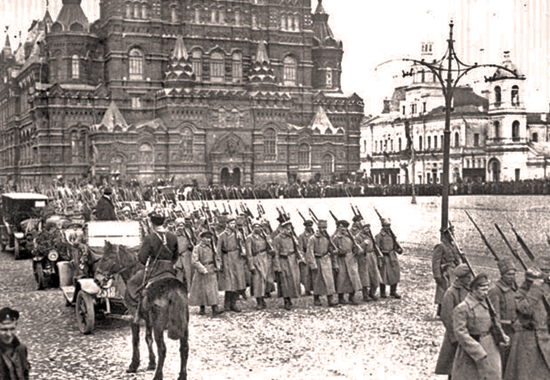
THE RUSSIAN CIVIL WAR
1917-1920
Defending the Victory of the Revolution
In a nutshell, the
Russian Civil War was the Bolsheviks' fight
to stay in power and to eliminate all
competitors.
|
|
And the Bolsheviks
won.
 Who were the Bolsheviks?
Who were the Bolsheviks?
Top Photo
The Bolsheviks in Moscow after the
 October
(November) Revolution 1917. The
building in the background is
Moscow's State Historical Museum.
October
(November) Revolution 1917. The
building in the background is
Moscow's State Historical Museum.
Source:
US
National Archives
Preparing
from the get-go to oppress all opponents, the
Bolsheviks actually shaped a
 totalitarian regime
from the start, a foundation that would almost inevitably provoke a civil war. totalitarian regime
from the start, a foundation that would almost inevitably provoke a civil war.
When exactly was the Russian Civil War
fought?
The Russian Civil
War - When did it start?
The Russian Civil War started on November 11,
1917 (October 29, 1917
 Old Style)
with the Cadet Uprising in Petrograd,
immediately after the Bolsheviks had come to
power by means of their October (November) Revolution.
Old Style)
with the Cadet Uprising in Petrograd,
immediately after the Bolsheviks had come to
power by means of their October (November) Revolution.
 Check the beginning of the Russian Civil War
in the timeline.
Check the beginning of the Russian Civil War
in the timeline.
|
Fighting continued
with the
 Battle of Pulkovo on November
13, 1917 (October
31,1917
Battle of Pulkovo on November
13, 1917 (October
31,1917
 old style).
old style).
Some historians
prefer early summer
1918 as the beginning of the
Russian Civil War, because by
then troops on either side had become more
organized. Larger armies had been mobilized and
fighting had become more frequent, justifying the term war rather
than occasional skirmishes.
If you are in
favor of placing the beginning of the Russian
Civil War at this later date, you will probably
tag previous smaller
armed conflicts as part of the
Russian Revolution of 1917.
Some experts are more specific and mark June 7, 1918 (May
25,1918
 old style)
as the date of the beginning of the Russian
Civil War. This was
the day of the battle between the Red Army and
the Czech Legion at
old style)
as the date of the beginning of the Russian
Civil War. This was
the day of the battle between the Red Army and
the Czech Legion at
 Chelyabinsk.
Chelyabinsk.
An argument
against this date could be that, by definition, a
civil war is a war between opposing groups of
citizens of the same country. Strictly speaking,
the Red Army encounter with the Czech Legion,
former prisoners of war trying to get out of the
country,
wasn't falling in this category.
However, people in
favor of June 7, 1918 as the beginning of the
Russian Civil War point to the fact that the
Czech Legion took sides in this conflict and
that it became a
powerful ally to one of the main participants. Thus,
this date should qualify.
More under
 Battles of the Russian
Civil War.
Battles of the Russian
Civil War.
The Russian Civil
War - When did it end?
The Russian Civil War ended on November 11, 1920
with the defeat of the White Forces, the Red
Army's chief enemy, on the Crimean peninsula.
The remaining scattered resistance was more or
less a matter of mopping up for the Bolsheviks.
 Check the end of the Russian Civil War
in the timeline.
Check the end of the Russian Civil War
in the timeline.
Some prefer
October 25, 1922 as the end of the Russian Civil
War. On this day the Japanese withdrew their
troops from one of the last anti-Bolshevik footholds, Vladivostok,
leaving the town to the Red Army.
Then, some see
December 30, 1922 as the end of the Russian Civil War,
when the Union of Soviet Socialist
Republics was formed, the day of the creation of
the Soviet Union.
Again others are of the
opinion that the Russian Civil War ended in June 1923
with the defeat of the last anti-Bolshevik army.
This last clash took place
along the Russian mainland coast of the
Sea of Okhotsk. Anatoly
Pepeliaev, or Pepelyayev, or
Pepelyaev, take your pick, led 700 volunteers in
their mission to
re-capture Yakutsk from the Reds, but he
couldn't pull it off. This was the final
significant move of the Whites.
 By
the way, was the Russian Civil War part of the
Russian Revolution? By
the way, was the Russian Civil War part of the
Russian Revolution?
Who were the main opponents in the Russian Civil
War?
Red Vs. White
The Bolsheviks, also called the
Reds, fought
against the
Anti-Bolsheviks, collectively called the
Whites.
The Reds
At the time, the political party of the
Bolsheviks was called the
All-Russian Communist Party.
The terms Red Army, the Reds,
the Bolsheviks, the Communists are
sometimes used interchangeably.
In politics, the
color red is traditionally associated with
leftist groups, socialism, and communism. The color red on a flag can symbolize
courage, toughness, and revolutionary political
views, the bridge being shed blood and violence.
The Whites
The terms White Movement, White Army, White
Guards and the like have their roots in the
historic connection between the color white and
royalism.
Russian emperors
were also called White Tsars. The color
white has been associated with royalist causes
since the late 18th century.
In spite of this
general connection that exists
between white and royal, it does
not mean that everybody connected with the White
Movement during the Russian Civil War was in
favor of a return to the monarchy. Some were,
some weren't.
However, white was
a good contrast to red, so the name stuck.
Let's keep in mind
that the expression White Movement, when used in
context of the Russian Civil War, refers to a
group of people with different agendas and
different ideas. But what they all had in common
was their disagreement with the Red Bolshevik
Communists.
Note that the
Whites did not get their name from White Russia,
which is another name for Belarus, a country in
Eastern Europe, nor from the White Russian
cocktail, which by the way is delicious and here
is the picture.

TWO WHITE
RUSSIANS
Let's hear it for
the guys
at scienceofdrink.com
The Red Army
The fighting force of the
Bolsheviks was the
Red
Army, in full the
Workers’ and Peasants’
Red Army, or Рабоче-Крестьянская
Красная Армия, if
you speak Russian.
The Red Army was
created on January 28, 1918 (January 15, 1918
 old style).
In 1946, the Red Army became the
Soviet Army.
old style).
In 1946, the Red Army became the
Soviet Army.
Red Army
- War Ministers, Commanders and Generals
|
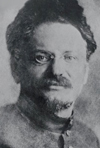 |
 Leon Trotsky
Leon Trotsky
People's
Commissar of War
(Bolshevik Government)
from
March 26, 1918 until January 17, 1925. |
Before
Trotsky became War Minister, the
position of the People's Commissar of
War and Navy was occupied by a committee
of three. Krylenko,
Dybenko and
Ovseyenko were the three members of that
committee from 1917 until 1918.
When
Trotsky became War Minister in March
1918, Krylenko became Commissar of
Justice, Dybenko got fired, and
Ovseyenko became commander of the troops
in Southern Russia.
|
Nikolay Nikolayevich
Dukhonin
Also spelled Nikolai
Nikolaevich Dukhonin.
In Russian: Николай Николаевич
Духонин
Supreme
Commander-in-Chief
November 1917. |
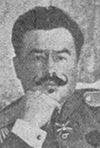 |
Dukhonin
was not a Red but somehow it makes sense
to list him here because he was in
charge of the Russian forces when the
Bolsheviks came to power.
Dukhonin
had been
 Kerensky's chief-of-staff. Kerensky
made him commander-in-chief when he,
Kerensky, had to flee because the
Bolsheviks shut down his government.
Kerensky's chief-of-staff. Kerensky
made him commander-in-chief when he,
Kerensky, had to flee because the
Bolsheviks shut down his government.
On
November 20, 1917 (November 7, 1917
 old style) the Bolsheviks
ordered Dukhonin to open peace
negotiations with the Central Powers
of World War I. Dukhonin refused and got
sacked.
old style) the Bolsheviks
ordered Dukhonin to open peace
negotiations with the Central Powers
of World War I. Dukhonin refused and got
sacked.
|
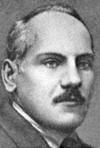 |
Nikolay Vasilyevich Krylenko
Also spelled Nikolai
Vasilevich Krilenko.
In Russian: Николай Васильевич
Крыленко
Supreme
Commander-in-Chief
from November 1917 until
September 1918. Dukhonin's
successor. |
People's
Commissar of War together with Dybenko
and Ovseyenko, before Trotsky took over.
From 1918 Commissar of
Justice.
|
Joachim Ioakimovich
Vatsetis
Also spelled Vacietis. In
Latvian: Jukums Vācietis.
In Russian: Иоаким Иоакимович
Вацетис
Supreme
Commander-in-Chief
from September 1918 until July
1919. Krylenko's successor. |
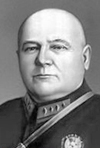 |
From Latvia.
Colonel in the Imperial Army. Commander of
the Eastern Front from July 10, 1918.
Arrested for conspiracy in July 1919. No
evidence was found and Vatsetis was released but not
given back his former job.
|
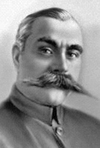 |
Sergey Sergeyevich Kamenev
Also
spelled Sergei Sergeievich
Kamenev
In Russian: Сергей Сергеевич Каменев
Supreme
Commander-in-Chief from
July 8, 1919 until April 1924.
Vatsetis' successor. |
S.S. Kamenev
(not Lev Kamenev!) became Commander of
the Eastern Front in September 1918. He was
fired
by Trotsky in July 1919. Reinstated shortly
thereafter by Lenin and Stalin and against
Trotsky's will, this time as
Commander-in-chief of all armed forces.
|
Mikhail Vasilevich Frunze
Also spelled Mikhail Vasilyevich Frunze.
In Russian: Михаил Васильевич
Фрунзе
Commander-in-Chief
of the Eastern Front
and later of the Southern Front. |
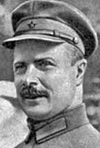 |
Became People's Commissar of War (Bolshevik
Government) after
Trotsky in January 1925. Died during surgery
on his stomach ulcers in
October 1925.
The
White Army
The fighting force
of the Whites was the White Army.
The
White Army was a cocktail of anti-Bolshevik
individuals.
The Provisional Government - War Ministers, Commanders and Generals
For the
sake of the big picture, we will back up a bit
and start with the military leaders of the
Provisional Government in March 1917.
|
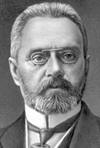 |
Aleksandr Ivanovich Guchkov
Also
spelled Alexander Ivanovich
Guchkov
In Russian: Александр
Иванович Гучков
Minister of War and Navy
(Provisional Government)
from March
15 - May 18, 1917. |
|
 Aleksandr
Fyodorovich Kerensky
Aleksandr
Fyodorovich Kerensky
Also spelled Alexander
Fedorovich Kerenskii
In Russian: Алекса́ндр Фёдорович
Ке́ренский
Minister of War and Navy
(Provisional Government)
from May 18
- September 12, 1917. |
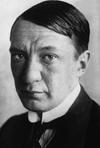 |
|
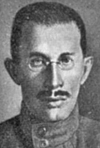 |
Alexander Ivanovich
Verkhovsky
Also spelled Aleksandr Ivanovich Verkhovski.
In Russian: Александр Иванович
Верховский
Minister of War
(Provisional Government)
from September 12 - November 6,
1917. |
|
Mikhail Vasilyevich
Alekseyev
Also spelled Mikhail Vasilevich Alekseev
In Russian Михаил Васильевич
Алексеев
Supreme
Commander-in-Chief
from March 15, 1917 until June
4, 1917. |
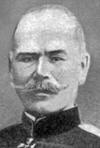 |
Together
with Kornilov, organized the
Volunteer Army
in the South.
|
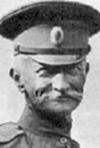 |
Aleksey Alekseyevich
Brusilov
Also spelled Aleksei Alekseev
Brusilov
In Russian Алексей Алексеевич
Брусилов
Supreme
Commander-in-Chief
from June 4, 1917 until
August 1, 1917
Alekseyev's successor. |
|
 Lavr Georgiyevich Kornilov
Lavr Georgiyevich Kornilov
In Russian Лавр Гео́ргиевич Корни́лов
Supreme
Commander-in-Chief
from August 1, 1917 until August 27, 1917
Brusilov's successor. |
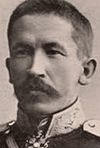 |
Together with
Alekseyev, Kornilov organized the
Volunteer Army
in the South.
Because of the
 Kornilov Affair,
Kornilov Affair,
 Kerensky dismissed Kornilov and made himself
Supreme Commander-in-Chief on August 27,
1917. As such, Kerensky performed until
November 7, 1917.
Kerensky dismissed Kornilov and made himself
Supreme Commander-in-Chief on August 27,
1917. As such, Kerensky performed until
November 7, 1917.
On November 7,
1917, Kerensky had to flee because of the
Bolshevik Revolution. He appointed
 Dukhonin
Supreme Commander-in-Chief.
Dukhonin held the post from November 7 until
November 22, 1917.
Dukhonin
Supreme Commander-in-Chief.
Dukhonin held the post from November 7 until
November 22, 1917.
After the Bolshevik Revolution - The White Army
|
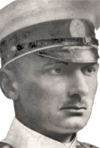 |
 Alexander Kolchak
Alexander Kolchak
Also spelled Aleksandr
Vasilyevich Kolchak
In Russian Алекса́ндр
Васи́льевич Колча́к |
Leader
of the anti-Bolshevik government at Omsk
from November 18, 1918 until January 4,
1920. War Minister in said government
from October 1918.
Commander
of the White forces in the
East.
|
Yevgeny
Karlovich Miller
Also spelled
Evgeni Karlovich Miller
In Russian Евгений Карлович
Миллер
Commander of the White forces in
the
North until the Reds
defeated his army and Miller
was seeking acceptable terms of
surrender on February 15, 1920. |
 |
|
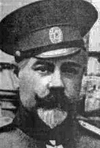 |
Anton Ivanovich
Denikin
In Russian Анто́н
Ива́нович Дени́кин
Commander of the White forces in the
South
until April 1920. |
|
Pyotr
Nikolayevich Wrangel
Also spelled Peter
Nikolaevich Wrangel
Commander of the
White forces in the
South
from April until November 1920,
when his army was defeated by
the Reds.
Denikin's successor. |
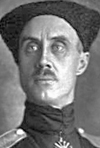 |
|
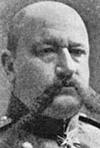 |
Nikolay Nikolayevich
Yudenich
Also
spelled Nikolai Nikolaevich
Iudenich
In Russian Николай Николаевич Юденич
Commander of the White forces in the
Northwest
until January 1920 when his army was
defeated by the Reds. |
See also the
 Map of the Russian
Civil War.
Map of the Russian
Civil War.
Who Else Fought in the Russian Civil War Against the
Bolsheviks?
Several
factions were strong enough to openly challenge
the Bolsheviks. Some were for counterrevolution,
others just wanted a piece of
the power pie. But the Bolsheviks had a no-share
policy and anyone claiming anything qualified to
be put on their target
list.
Target 1 - The Russian
Orthodox Church
Easiest of all targets because mostly unarmed.
By definition, the Bolsheviks thought religion
to be unscientific. Besides, having their
government financially support an institution
that would compete in influencing the nation was
out of the question.
Already in 1917, the
Bolsheviks nationalized Orthodox church lands,
took over all Orthodox schools, and allowed
only civil marriages.
In 1918, a law
followed that completely separated church and
state, exposing religious organizations to
random assaults.
 Check this event in the
Timeline of the Russian Civil War.
Check this event in the
Timeline of the Russian Civil War.
The church lost all its legal rights and brutal
harassment followed in form of attacks on priests, arrests
and executions of clerics, and looting of
churches. The spiritual void
was filled with atheist propaganda.
It didn't go downhill
for the Russian Orthodox Church alone, but for
religion in general throughout the country, no matter what shape or
form.
Target 2 -
The Socialist
Revolutionary Party
The Socialist Revolutionaries (SRs) split over
the Bolshevik Revolution (November 1917) into
left wing and right wing.
By the end of the
Russian Civil War, the Socialist Revolutionary
Party had vanished, left wing and right wing.
Target 3 - The Komuch
Komuch is
short for Комите́т чле́нов Всероссийского
Учреди́тельного собра́ния, which means Committee of
Members of the Constituent Assembly
in Russian.
The committee was composed of Socialist
Revolutionaries with headquarters at Samara. It was formed in protest of the Bolsheviks'
dispersion of the Constituent Assembly in
January 1918.
 Check this event in
the timeline of the Russian Civil War.
Check this event in
the timeline of the Russian Civil War.
The Komuch had
mainly two points on their agenda.
1 - They were against the
 Treaty of Brest-Litovsk.
Treaty of Brest-Litovsk.
2 - They wanted to restore the Constituent
Assembly.
The Komuch set up
an anti-Bolshevik government on the Volga on
June 8, 1918. The Komuch also
mustered an army, the
People's Army.
Target 4 -
The
Mensheviks
Together with the Right Socialist
Revolutionaries ( see above)
the Mensheviks formed a joined opposition.
see above)
the Mensheviks formed a joined opposition.
 Where did the
Mensheviks come from?
Where did the
Mensheviks come from?
Target 5 - The
Czechoslovak Legion
Also called Czech Legion. These were
approx. 30,000 soldiers, formerly fighting in
the Austrian-Hungarian army who were captured by
the Russians. The Austrian-Hungarian army is
also called the
Habsburg Army because the
 Habsburg
dynasty ruled the country. Habsburg
dynasty ruled the country.
By
the way, one of these soldiers was
Ludvík Svoboda
who would become president of Czechoslovakia in
1968.
Back to the
prisoners of war.
The Provisional
Government under Kerensky released these
troops from their prison camps, armed them, and
wished them all the best and a safe trip home.
Deserters from the
Austro-Hungarian Army and others joined the
Czech Legion and eventually this group counted approx.
100,000 heads.
The goal of the Czech Legion was to get
to the Western Front before the end of
 WWI, to
claim national independency from Austria-Hungary,
and to fight with the Allies against their
former employer, the Austrian government.
WWI, to
claim national independency from Austria-Hungary,
and to fight with the Allies against their
former employer, the Austrian government.
Here is Austria-Hungary on a map. Prague, the
capital of today's Czech Republic, is positioned
in square "eH".
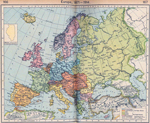
1871-1914
Europe
Click to enlarge
And here is a map of the Allies and the Central
Powers in World War One.
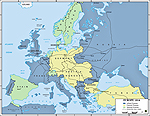
1914 Europe: Allied,
Central, and Neutral Powers
Click to enlarge
The question for the Czech Legion was, how
to get back home. It was impossible to take the direct way
back through the battle lines of WWI. So, the
idea was to reach Vladivostok by Trans-Siberian
Railway and to depart from Vladivostok via ship.
Here is a map of the
Trans-Siberian Railway
as well as the departure and destination points
of the voyage of the Czech troops.
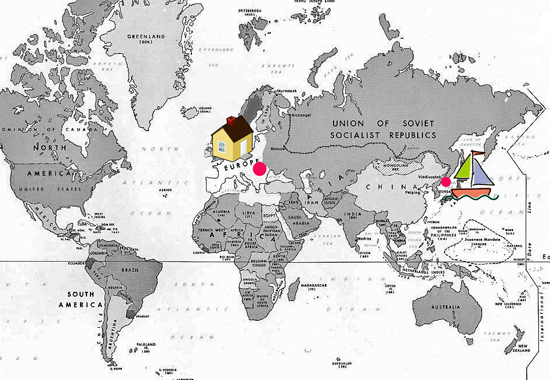
The Czech Legion's way home from Russia
Map of the departure and destination points
Click to view
original World Map 1919 (enlarged)
Now here was the predicament.
In March 1918, the
trip was approved by the Bolshevik government.
But some of the Bolsheviks en route became extremely sensitive upon seeing
an armed
non-Russian group maneuvering through their
countryside. And rightly so. Although not taking
sides in Russian politics, this
outfit was disciplined and knew
how to fight, something Russian revolutionary leaders
could only dream about those days.
The Reds tagged them as potential
counterrevolutionaries. Skirmishes ensued.
At the end of May,
the Bolshevik government ordered
the Czechoslovak Legion
to
surrender their arms. The Czechs preferred not to
become prisoners again, refused the order, took control of
the trans-Siberian railroad,
teamed up with the Right Socialist
Revolutionaries in Samara, and consequently
found themselves in the middle of the Russian Civil War.
 Check
this in the timeline of the Russian Civil
War. Check
this in the timeline of the Russian Civil
War.
Finally arriving in Vladivostok, the Czechs took the boat
direction San Francisco, United States. From
there, cross country, across the Atlantic and
eventually back to Europe. The departure of the
entire corps from Russia took from May to
December 1919.
Target 6 - The
Siberian Army
Anti-Bolshevik troops from Omsk, led by
 Alexander Kolchak.
Alexander Kolchak.
Target 7 - The
Ukrainian Army
The Ukraine was ready for
independence and declared itself a sovereign
republic in 1918. Symon
Vasylevych Petlyura led the Ukrainian
Army.
Target 8 - The Don Army
Anti-Bolshevik Cossacks from the Don, led by
Pyotr Nikolayevich
Krasnov.
Target 9 - Other
Independence Seeking Nations
Azerbaijan declared independence in 1918, and so
did Georgia. The Soviet Republic of Armenia was
established in 1920. The Reds had all of the
above back in the fold by 1936.
Target 10 -
The Black Army
Anarchists in the Ukraine, led by
Nestor Ivanovich Makhno, who fought very effectively as guerrillas. At least
for a while. The Blacks were against Reds
and Whites alike.
 What is anarchism?
What is anarchism?
 What is guerrilla warfare?
What is guerrilla warfare?
Target 11 - The
Green Army
Around 40,000, maybe more, angry peasants from the Tambov
region who, siding with neither Red nor White,
became brothers-in-arms in August 1920. Also
referred to as the
Tambov Uprising
or the Tambov Rebellion.
Leader of the
rebellion was Petr
Mikhailovich Tokmakov, also spelled
Pyotr Mikhailovich Tokmakov or Peter Mikhailovich Tokmakov. Tokmakov was killed in
battle in early 1921.
Here is Tambov on
a Google map.
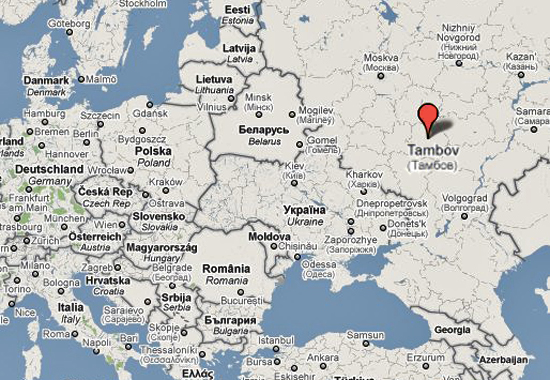
Map Location of Tambov - City and Region in
Western Russia
Google Map
Target 12 - The Basmachi
Also
spelled Basmachestvo. Muslim guerrilla
fighters based at Tashkent, located in today's
Uzbekistan. The
Basmachi Revolt started in 1917 and
was crushed by 1926.
Target 13 - The
Central Powers and the Allies of WWI
White forces
also received support from foreign powers.
Before their
surrender in WWI on November 11, 1918, the
Germans helped out with arms and ammunition.
France and Britain
disliked the Bolsheviks as well and assisted the
Whites. In fact,
 Churchill became famous for his
fiery hate of the Bolsheviks. Churchill became famous for his
fiery hate of the Bolsheviks.
What about WWI
strategies?
The Allies of WWI had their panties in a bunch
on the Eastern Front and were desperately
craving a breather. Their goal was to create a Western
Front
that would keep the Central Powers busy and
distracted. In March 1918, and with the
permission from the Soviets, the Allies landed
at Murmansk.
Sly Japanese
forces thought they might as well and landed at
Vladivostok, without any
permission. However, the
Japanese had an agreement with the Americans.
The U.S. sent
troops to Archangel (Archangelsk) calling it the
 Polar Bear Expedition
and to Vladivostok on the
Polar Bear Expedition
and to Vladivostok on the
 Siberian Expedition.
The Siberian Expedition was organized to keep an
eye on Japan, who was playing with thoughts of
territorial expansion.
Siberian Expedition.
The Siberian Expedition was organized to keep an
eye on Japan, who was playing with thoughts of
territorial expansion.
Here once more the
map that shows Allies and Central Powers of WWI.

1914 Europe: Allied,
Central, and Neutral Powers
Click to enlarge
The Events Unfold
Here are the timelines
of the Russian Civil War 1917 - 1920.
 Timeline of the Russian
Civil War 1917
Timeline of the Russian
Civil War 1917
 Timeline of the
Russian Civil War 1918
Timeline of the
Russian Civil War 1918
 Timeline of the
Russian Civil War 1919
Timeline of the
Russian Civil War 1919
 Timeline of the
Russian Civil War 1920
Timeline of the
Russian Civil War 1920
The
Battles of the Russian Civil War
|
November 11, 1917
(October 29,1917
 Old Style)
Old Style) |
 Cadet Uprising,
Petrograd
Cadet Uprising,
Petrograd |
| |
|
|
November 13, 1917
(October 31,1917
 Old Style)
Old Style) |
 Battle
of Pulkovo
Battle
of Pulkovo |
| |
|
|
April 10 - 13, 1918 |
 Battle of
Yekaterinodar
Battle of
Yekaterinodar |
| |
|
|
August - Mid-September 1918 |
First
Battle of Tsaritsyn
also called
 Siege of
Tsaritsyn
Siege of
Tsaritsyn
(Later, Tsaritsyn becomes
Stalingrad, it is today's Volgograd) |
| |
|
|
August 13, 1918 |
 Battle of Sviiazhsk
Battle of Sviiazhsk |
| |
|
|
September 22 - October 15, 1918 |
 Second
Battle of Tsaritsyn
Second
Battle of Tsaritsyn |
| |
|
|
December 1918 |
Third
Battle of Tsaritsyn |
| |
|
|
Mid-January 1919 |
Fourth Battle
of Tsaritsyn |
| |
|
|
September 26, 1919 |
 Battle
of Peregonovka (Battle of
Perehonivka)
Battle
of Peregonovka (Battle of
Perehonivka) |
| |
|
|
October 13, 1919 |
 Battle
of Orel
Battle
of Orel |
| |
|
|
August 14 - 16, 1920 |
 Battle of Warsaw
Battle of Warsaw
This battle was
part of the Russo-Polish War |
| |
|
|
November 7 - 12, 1920 |
 Battle
of Perekop
Battle
of Perekop |
| |
|
How Many People Died in the Russian Civil War?
Historians
estimate the number of combined casualties of
the Russian Civil War (military, civilian,
famine, and disease) to have been a total of between eight and
ten million deaths.
The Outcome of the Russian Civil War
The Red Army
defeated the last big batch of White Army
troops, who had fought under
Baron Pyotr
Nikolayevich Wrangel, in November
1920 and the Russian
Civil War was officially over, won by the Bolsheviks.
-
One main reason
for the victory of the Red Army was their
military superiority.
-
Another reason
was their political focus. The Reds had a
common ideology whereas the Whites were only
united because of their common dislike of
the Reds.
-
A third reason
was the strategic advantage of the Reds who
had to defend a core area, whereas the
Whites had coordination troubles especially
with communications and logistics because of
the large distances that kept them apart.
For the Russian nation, the Bolshevik victory of
the Civil War meant the absolute rule
of the Communist Party.
The Communist Party, in turn, was controlled by
its Central Committee. The Central Committee was
managed by the
 Politburo,
making the Chairman of the Politburo the
potentially most
powerful man in the country. Politburo,
making the Chairman of the Politburo the
potentially most
powerful man in the country.
Stalin would be
the man ready to exploit this loophole. The
Russians therefore dethroned an absolute ruler
in favor of an absolute ruler who didn't need a
throne.
The Economy During the Russian Civil War
How do you
switch from capitalism to socialism? The
Bolsheviks' attempt is called War Communism.
 What is War Communism?
What is War Communism?
What Happened After the Russian Civil War
1917-1920?
After
winning the Russian Civil War, the Bolsheviks
had to ease up on their politics in order to
keep the general populace alive. The compromise
was called the
 New Economic Policy
(NEP) and was in place from 1921 until 1928. New Economic Policy
(NEP) and was in place from 1921 until 1928.
Lenin died in
January 1924 and
 Josef Stalin
was the next
leader of the Communist Party and the country.
Stalin kept his comrades on their toes by means
of his
Josef Stalin
was the next
leader of the Communist Party and the country.
Stalin kept his comrades on their toes by means
of his
 Great Purges of 1937 -
1938.
Great Purges of 1937 -
1938.
More History
|